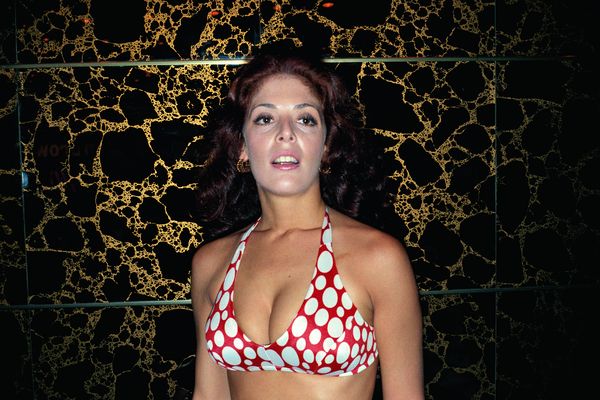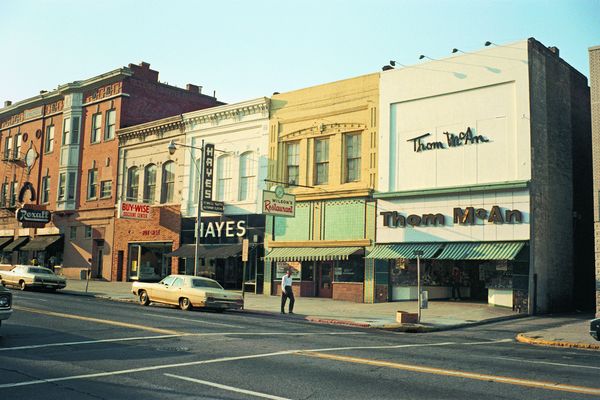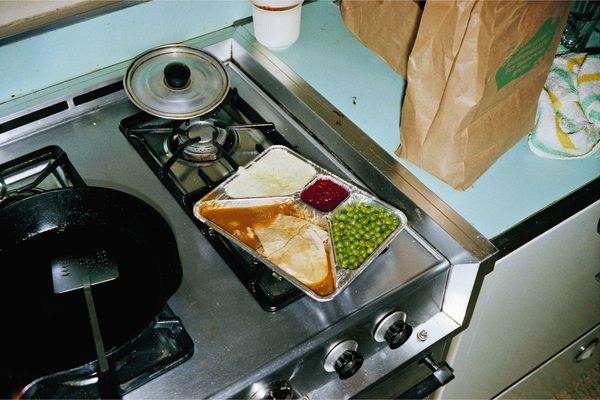Stephen Shore Mineral Wells, Texas, June 1972. © Stephen Shore. Courtesy 303 Gallery, New York.
Stephen Shore’s photographs of 'American Surfaces' were taken on travels across America in 1972-1973. Over Zoom, Phillips’ Deputy Chairwoman, Americas and Worldwide Head of Photographs, Vanessa Hallett, came together with Stephen to discuss this seminal body of work.
VANESSA HALLETT: Hi Stephen, it's nice to meet you and I am so pleased that you’re joining us for this interview.
STEPHEN SHORE: Glad I could do it.
Stephen Shore Monroe, Louisiana, June 1972. © Stephen Shore. Courtesy 303 Gallery, New York.
VH: You were born in New York City but your journey took you through small-town America. Were you looking to photograph communities that felt familiar to you or those that felt different from where and how you grew up?
SS: Well, I grew up as you said in New York City and most of the traveling I did was to Europe. But then, in 1969, I went to Texas with some friends of mine who were from Amarillo, and I started going there more in the summers and was introduced to part of the country that I hadn’t experienced before. We sometimes used Amarillo as a base for other trips and I wanted to explore that. So, it was unfamiliar to me and I felt very much like an explorer venturing out into a country I didn’t know.
VH: How did working in color affect your choice of subject matter, or did it affect it at all?
SS: Color adds a new layer of information to the subject -- it does two things: one is that it adds transparency, and by transparency, I mean that you have the sense of looking through the photograph without constantly being reminded that it’s a photograph. But the other thing is that color can communicate the palette of age and the palette of culture, and that was something I was particularly interested in. I might say that the title of the project American Surfaces didn’t come to me afterward. When I was doing the show in 1972, it was a title I had in my mind when I began the trip. I was interested literally in the surface of things, what things looked like.
Stephen Shore New York City, New York, August 1972. © Stephen Shore. Courtesy 303 Gallery, New York.
VH: Were you trying to fulfill the title or did you see things that fit the title?
SS: I wasn’t working that closely with the title, but I had that in my mind that this was a general orientation that I was looking at, the surfaces that I encountered, the literal surfaces. What is the external appearance of this world I was entering into? And, so, color played an important role in that.
VH: The images in the book really capture the full spectrum of life, from the whimsical and humorous to the introspective to the downright messy – do you find yourself gravitating to one of these more than the others?
SS: Not particularly. I think the way the project developed, there were two things I had in mind: It was really a formal question, it was a question of visual style, that was to take pictures referencing the experience of seeing rather than referencing photographic composition. Rather than making them look like photographs, I wanted to make them to look like what the act of seeing was like. And I knew I wanted to explore the country. About 3 days into the trip, I realized I was photographing repeated situations: the meals I was eating, the beds I was sleeping in, and saw this as a kind of visual diary made up of a number of visual series. I was already interested in serial imagery, having spent several formative years at Warhol’s factory, but saw a kind of series of series that together would give a portrait of the culture that I was looking at. I was photographing every meal I ate, every bed I slept in, every person I met, the televisions I looked at, residential architecture, commercial architecture, main streets and more. Within a couple of days, the idea of a kind of visual diary became clear to me.
Stephen Shore Macon, Georgia, June 1972. © Stephen Shore. Courtesy 303 Gallery, New York.
VH: In many ways, the book comes across as a visual stream of consciousness, for the reasons you just explained, and as Teju Cole states in the introduction, “a screenshot of his field of vision.” How do you edit a body of work like this, or even known when it’s finished?
SS: In terms of editing the work, the following year in ‘73, I became friends with the German artist Hilla Becher, and Hilla said to me, “What you ought to do is take photographs of every main street in America,” and I remember my response, I said “Hilla, that’s what you would do. I want a quintessential main street,” and I think that’s an answer to your question about editing. It’s one thing to think of a series of say, food pictures, but some seem more quintessential, more of a distillation of a key experience than others, and I didn’t have a problem editing it down to those.
Stephen Shore New York City, New York, September–October 1972. © Stephen Shore. Courtesy 303 Gallery, New York.
VH: It sounds like you’re a quick editor of your work, you could say.
SS: Not necessarily, and when I said I didn’t have a problem editing down, I meant I didn’t feel an obligation to include everything. There’s a lot of work, and the current edition has grown out of looking at some of the pictures that didn’t make it into the previous edition. There were a lot of pictures in the original show in ‘72 that were not included in the previous Phaidon edition of American Surfaces. When The Museum of Modern Art gave me my retrospective in 2017, the curator of the show, Quentin Bajac, wanted to recreate the American Surfaces show. I continued for about half a year photographing for the project after the show went up so Quentin could avail himself of the entire body of work. We decided to expand the original Phaidon book to include those.
VH: A copy of John Szarkowski’s 1971 book on Walker Evans appears on page 233. How did Walker Evans’ way of seeing America affect your vision of the country?
SS: The first photography book I ever owned was Walker Evans’ American Photographs. A neighbor of mine gave it to me for my 10th birthday. I think my relationship with Walker Evans goes beyond saying he influenced me; I would say that there is a kind of spiritual kinship between us; that there’s something temperamentally connected. That the way he sees the world and the way he sees art resonates deeply with me. This might not just be learned by looking at his work, but something innate, in my personality. His work means more to me than almost any other photographer.
Stephen Shore Clovis, New Mexico, June 1972. © Stephen Shore. Courtesy 303 Gallery, New York
VH: You have an amazing Instagram account, @stephen.shore, that you and your followers clearly enjoy, including myself. What opportunities do you feel it affords you and what do you enjoy most about it?
SS: There are a lot of things I enjoy about it. The work I post on Instagram I post, just to be clear, is work that I take on my phone every day, and post within a day or so of taking it. I’m not going through my archives as some photographers do and pick my best pictures. I am doing work specifically with Instagram in mind, knowing it’s going to be seen on phones or iPads. I like that discipline. As I go through the day, I have in my mind what am I going to photograph today, what I am going to post today. I also like the visual community that develops on Instagram. I mean, there are literally a billion users.
However, there are groups of photographers all over the world who are posting pictures that they’re taking with their phone for Instagram and it’s this visual conversation that’s going on and it feels very personal. I think in time, one begins to get the tempo of someone else’s visual thinking. When I’ve met some of the people I’ve been following, I feel like I’m meeting an old friend.
VH: I see your point. I often meet people that I know from Instagram, professionally, personally, and you feel you do know them.
SS: At the opening of my retrospective at MoMA, I invited a number of the people that I’d been following on Instagram and who had been following me and didn’t know each other. To watch them meet each other, have this recognition when I give their Instagram handle, their faces would light up -- there was this excitement of meeting this person who you have this very close daily communication with.
Stephen Shore Farmington, New Mexico, June 1972. © Stephen Shore. Courtesy 303 Gallery, New York.
VH: The connections of Instagram. Incredible.
SS: I’ll tell you what it grew out of, and this goes back to something we talked about in the beginning of our conversation, which was the idea of wanting to take pictures that looked like the experience of seeing. You had mentioned Teju Cole referencing mental screenshots, and what he’s talking about is this: as a way of gathering information about what seeing looks like during the day, I would take a screenshot of my field of vision. Screenshot isn’t a word I would have used then, it didn’t exist then, but that’s a clear way that we would understand now of describing what I was doing -- when I was walking down the street, in the back of a taxi, in an elevator, having a conversation with a friend. At just random times, whenever the thought crossed my mind, I would stop and essentially take a screenshot of what the experience of looking looked like. If I were a camera, what would it look like? And because I was doing that, I started paying attention to things that normally or conventionally wouldn’t have been photographed, like a payphone I was talking on or the partition in the back of a taxi. Three times a day I sat in front of food, and often I was taking a screenshot of the meals in front of me. So all of this became the resource that American Surfaces grew out of and that’s where these great common subjects came from – just paying attention all day long.
One other thing: a lot of the work I put on Instagram is made with phones, and one of the differences between photographing with a phone and photographing with a more traditional camera that you would hold up to your eye is that you don’t see through your phone. The phone doesn’t become an extension of your eye; you’re looking at a display, so even if you aren’t a self-conscious artist, just an average person picking up their phone to take a picture, at least unconsciously it reminds you that you’re looking at an image of something and not the thing itself. I think that leads to a kind of innate self-awareness in a lot of the pictures.
VH: Absolutely! Thank you so much for speaking with me and with Phillips. We’re really excited about the new edition of 'American Surfaces.'
Learn more about American Surfaces at Phaidon, and use code PHILLIPS20 for 20% off >







